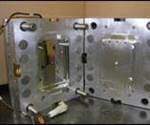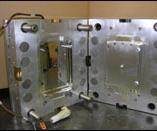Challenges in Blow Mold Design
Blow mold design and build requirements—as well as challenges and how to overcome them—through the use of a new rotary blow molding wheel system.
It is safe to say that the today’s world is a fast-paced one—it is not only in the moldmaking shop that people want to get things done quicker than ever. With a majority of the population constantly on the go, the market for single-serving containers (plastic bottles) of both beverages and foods is exploding. While designing and building blow molds is challenging, it is a niche worth exploring.
On the molder end, production requirements for a single type package can reach 100, 200, or even 400 million containers per year, so molders need the best, least complex, and the most economical machinery that can handle these extreme production rates—along with blow molds that can stand the test of time and take a beating.
According to Jeff Newman, VP of sales and marketing at Wilmington, NC-based Wilmington Machinery—a provider of machinery and processes to produce high output packaging and structural plastic parts—this trend is a global one that is driven by many factors, including the following: school milk programs conversion from paper to plastic, new package developments targeted at the convenience and health food markets, and changing economical factors and consumer habits in Latin American and Asian countries.
This translates into some lucrative business on the blow molding end. Some blow molding equipment manufacturers have responded with new machines designed to handle this trend, which results in design challenges for blow moldmakers.
Wilmington Machinery has built a rotary blow molding wheel system that blow molds small bottles in a single cavity mold and uses a proprietary method of guiding the containers from under the blow molder through the trimmer at extremely high speeds with maximum efficiency. This article will detail blow mold design/build requirements as well as challenges and how to overcome them through the use of this new machine.
Blow Mold Design and Build Requirements
Al Vanover, V.P. of Marketing at Mid-America Machining (Brooklyn, MI)—a producer of blow molds, trim tooling and other related tooling—states that depending upon the technology and machine platform, the mold has certain dynamics, which means there must be a minimum obligation on the machinery manufacturer to accommodate.
“A mold of a certain size needs to have a sufficient platen size and clamp force to allow the mold to function properly,” Vanover elaborates. “With new machinery technology and different means of blowing a container, there are always explorations on how to blow the container faster, exhaust the air and cool the flash, which is the moldmakers’ challenge today.
“With higher cavitation machinery and sometimes faster cycle time requirements, we cannot lose sight of those key attributes that make ‘a good mold a great machine,’” he continues. “In the competitive blow moldmaking environment, we believe value-added is the best ingredient to success. Whether it is the cooling design, the cavity layout, the mold materials or the proprietary technology that exists, the design process continues to evolve with almost every project.”
Wilmington Machinery’s high-speed, small bottle (SB) rotary blow molding wheel system uses a miniaturized version of the company’s mechanical clamping systems—a technology originally perfected in their larger wheel machines—combined with a proven technique for accurately positioning the clamps and molds relative to each other.
Newman points out that this new technology was developed because traditional methods were not yielding productive results. “Some blow molding machinery manufacturers have begun promoting tandem blow—the process of blow molding two bottles per parison that have been configured in a neck-to-neck or base-to-base arrangement in the mold,” Newman states. “Their rationale is not necessarily that this technique produces better bottles, but that it is the only way to increase output without incurring the additional cost of multiple machines.
“However, producing two identical bottles in a tandem blow process is a problematic challenge, especially with free falling parisons typically used by shuttle and reciprocating blow molding machines,” Newman continues. “The parison shape is never identical from the top to bottom in the mold; and achieving an identical material distribution in the top and bottom containers can be next to impossible. Additional variation is added by trying to balance and set up four, six, eight or more parisons to be identical. Even with wheel machines the physical variations in bottles blown in a tandem process can never be totally eliminated.”
The new machine’s system uses a single parison and individual cavities, instead of tandem, in order to produce the highest quality bottles with the least variation in material distribution bottle-to-bottle, and with the smallest weight variation.
Working Together
Wilmington Machinery worked closely with Mid-America Machining through the design and build of this machine so the new machine could satisfy blow moldmaking design considerations.
“The key to the technology is partly the machine and partly the fact that we developed a method and a concept that allowed us to blow the blow molded bottles between the molds,” Newman notes. “So, when one bottle blows on mold number one it actually inflates the parison in mold number one and part of mold number two. In order to do this, two things had to happen: we had to come up with a very special mold design concept that would allow us to do that and we also had to have a machine that was built with extreme precision. When we actually blew the parison between the molds, the position of the molds had to be very closely regulated so that the gap between the molds was kept to .010 inches or less. If it was more than that, instead of the plastic inflating, it would blow out and the air pressure would escape.”
Features of the blow mold that Mid-America and Wilmington Machinery designed include a specially designed blow needle cylinder requiring only a single pneumatic air supply; and the pinch design on the base of the mold that allowed us to accomplish the very first 24-station wheel for the small bottles. Since that time, the company has sold several very large cavitation machines that exceed 50 molds per blow molding wheel for multi-layer applications.
“The hardest part of this for moldmakers to grasp is the special design of the flash area, which is the area of the container we trim off,” Newman comments. “It has some very precise and complex geometry to allow the process to work in the flash area—especially at the base of the bottle, that is, the tail of the mold. That geometry has to accomplish several things. It has to separate or cut the bottle at the base pinch, so we separate between the molds by using the base pinch design. At the same time, that geometry has to help us hold the bottle in the mold for mold number two, when mold number one opens. The other part of this is that with our technology we do not require cut-off knives between the molds or knock-out rods, which would typically be required on wheel blow molding machinery.
“As a result, the molds are less expensive and in some ways can be less complicated—with the exception of the geometry design and the tolerance that we have to hold at the base pinch,” Newman adds.
Challenges/Solutions
Wilmington Machinery’s prime objective in designing the new machine was to eliminate the problems associated with high-speed bottle handling and to make the new system extremely simple to set up, operate and maintain, Newman explains. “This machine was designed specifically for high-speed, high-volume, single-serve dairy, food, juice and liquid yogurt applications for containers 200 to 500 ml,” he says. “A smaller clamp has been added to handle bottles sizes as small as 80 ml. These machines are economical, extremely simple and can be built with up to 60 cavities at speeds up to 30,000 bottles per hour—depending upon the container. Like their larger machines, the extrusion rates and layer configuration can be designed to match any application such as white-black-white or barrier bottles.”
Newman explains that processors now have the ability to blow each bottle in individual molds while totally eliminating the need for high maintenance bottle knockout systems, complicated bottle takeout devices and cut off knives or shear steels.
“Lighter, quicker, innovative and improving the performance characteristics continue to challenge the blow moldmaking community,” Vanover of Mid-American Machining states. He adds that the company has a great deal of knowledge about the blow molding process, which gives them a distinct advantage.
“We are able to develop the container concept—and depending upon the scope of the project—we are capable of not only delivering the finished mold, but sampling of the mold, development of extrusion tooling and in some case moving quickly to production tooling or commencing with further development. It is all part of the solution to single-serve package development.”
Related Content
MMT Chats: Acquisition Trends and Lessons for Mold Builders
Jim Berklas is a former full-time M&A lawyer for several of the largest private equity firms in the country and has 25 years of M&A experience and 200 closed transaction. Today, he is founder and M&A Leader with Augmented Industry Services. He joins me for this MMT Chat on mergers and acquisitions trends and strategies within in the mold manufacturing industry. This episode is brought to you by ISCAR with New Ideas for Machining Intelligently.
Read MoreMold Design Review: The Complete Checklist
Gerardo (Jerry) Miranda III, former global tooling manager for Oakley sunglasses, reshares his complete mold design checklist, an essential part of the product time and cost-to-market process.
Read MoreOEE Monitoring System Addresses Root Cause of Machine Downtime
Unique sensor and patent-pending algorithm of the Amper machine analytics system measures current draw to quickly and inexpensively inform manufacturers which machines are down and why.
Read MoreThe Role of Social Media in Manufacturing
Charles Daniels CFO of Wepco Plastics shares insights on the role of social media in manufacturing, how to improve the “business” side of a small mold shop and continually developing culture.
Read MoreRead Next
Choosing the Right Aluminum Alloy for Production Injection Molds
Aluminum may be a better solution than steel after a thorough review of part design, tool design, quantity and type of unfilled, aluminum-friendly resin.
Read MoreAre You a Moldmaker Considering 3D Printing? Consider the 3D Printing Workshop at NPE2024
Presentations will cover 3D printing for mold tooling, material innovation, product development, bridge production and full-scale, high-volume additive manufacturing.
Read MoreHow to Use Continuing Education to Remain Competitive in Moldmaking
Continued training helps moldmakers make tooling decisions and properly use the latest cutting tool to efficiently machine high-quality molds.
Read More
















.jpg;maxWidth=300;quality=90)


_300x250 4.png;maxWidth=300;quality=90)








